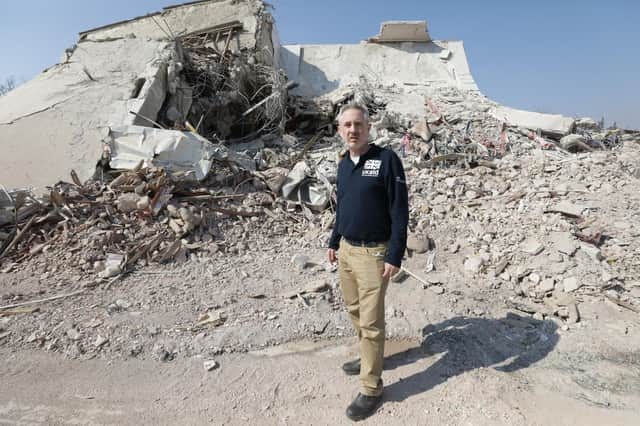Borderer leading aid effort in earthquake-hit Turkey


Erlend Linklater has regularly faced danger in conflict-hit countries including Afghanistan, Angola, Colombia, Sudan and south Sudan during his career as an aid worker.
But the 48-year-old from Selkirk has told how the killer 7.8-magnitude earthquake earlier this year did more damage in 80 seconds than cities flattened by months of military bombing.
Advertisement
Hide AdAdvertisement
Hide AdSelkirk-born Erlend’s job as a humanitarian advisor with the Foreign, Commonwealth and Development Office (FCDO) has seen him visit some of the areas worst-hit by the February 6 natural disaster.
He said: “I’ve worked in a lot of fragile conflict areas and what I’ve seen in some parts of Turkey looks like a war zone.
“It looks like there’s been a sustained bombing campaign over a prolonged period of time.
"The scariest thing is the earthquake took less than two minutes to cause such destruction.
Advertisement
Hide AdAdvertisement
Hide Ad“What blows your mind is that the power of the earthquake has literally turned some buildings to dust.
“I’ve worked for a number of years in live conflicts with plenty of shooting and bombing going on, but in terms of the impact emotionally, this is one of the hardest things I’ve had to work on.”
Erlend has been at the forefront of the UK Government’s humanitarian response since being scrambled into action less than two hours after the earthquake had struck just after 4am on February 6.
Erlend helped oversee the deployment of 77 search and rescue experts from the UK to help find survivors in the rubble, including four firefighters from Scotland.
Advertisement
Hide AdAdvertisement
Hide AdAnkara-based Erlend also helped coordinate the launch of a joint FCDO/MoD field hospital in Gaziantep, southern Turkey, which has treated over 20,000 patients, as part of a £43million UK Government package of humanitarian support.
He said: “What you see on the telly can never prepare you for the full scale of the devastation when you see it with your own eyes.
“One of the drivers who showed us round, said he’d lost 100 family and friends in the disaster.
"His entire social network has been utterly wiped out.
“It’s killed over 50,000 people across the region – that’s like the whole population of Perth, Kirkcaldy or Cumbernauld.
"A further 107,000 people were injured.
Advertisement
Hide AdAdvertisement
Hide Ad“I don’t think there is a person in the affected areas who will not know somebody who has died. So many people are grieving.
“Some of the worst affected places like Hatay were places I knew well, visited frequently, and was fond of, which has compounded it and made it hit home even harder.
“In Hatay, considered one of the cradles of civilisation, so many buildings have been damaged or destroyed.
“The main street that leads to the historic centre, which I loved walking down, was completely destroyed.
Advertisement
Hide AdAdvertisement
Hide Ad“Whole buildings had just pancaked down. The first couple of floors had completely disappeared and you could see the main concrete layer between each floor just sitting on top of each other with absolutely nothing left in between.
“If you work in conflict areas, you are used to seeing destroyed buildings, but if they are near the front line then often the civilian population has been evacuated. The scary thing about the earthquake is there was no warning and it happened at four o’clock in the morning when most people were asleep, meaning every collapsed building you look at is a mass graveyard.
“Little shops and cafes where I’d had so many pleasant chats were flattened and now that place no longer exists.
“There were places where you could see the earth had literally moved. The ground had split and was now on different levels.
Advertisement
Hide AdAdvertisement
Hide Ad“There is a bridge that we crossed where it had literally split in two and you could look down through the gap and you could see the earth had just parted in a significant way.”
Erlend was caught up in some of the aftershocks, including an earthquake that measured 5.1 on the Richter scale.
He admitted: “When I was down there in the immediate aftermath, you were constantly on edge because you had aftershocks still going.
“Some buildings subsequently collapsed from the aftershocks. Another 5.1 aftershock shook the building I was in. It felt like a bus or a lorry had hit the building in a shunt.
Advertisement
Hide AdAdvertisement
Hide Ad“There were other ones where the world around you begins to move and it’s almost as if you’ve lost your balance. It does un-nerve you."
Erlend’s job at the British Embassy in Ankara meant he was already assisting the 3.7m refugees who had fled civil war in Syria to cross the border into Turkey, 1.7m of whom resided in the earthquake-hit area.
He said: “In what was already a very challenging environment, the scale of destruction means that many people have been left with literally nothing other than the clothes they were wearing.
“They have lost everything in collapsed houses, if they were lucky to escape with their lives. shops and markets have been destroyed and people no longer even have kitchens to cook in.
Advertisement
Hide AdAdvertisement
Hide Ad“We are continuing work providing shelter, support for basic items, water sanitation and hygiene and doing everything we can to minimise the spread of disease.
“The scale of the challenge facing us can seem so daunting but the fact that the UK raised over £100m during a cost-of-living crisis shows the British public is right behind this response. We stand in solidarity with the people of Turkey and northern Syria in their hour of need.”